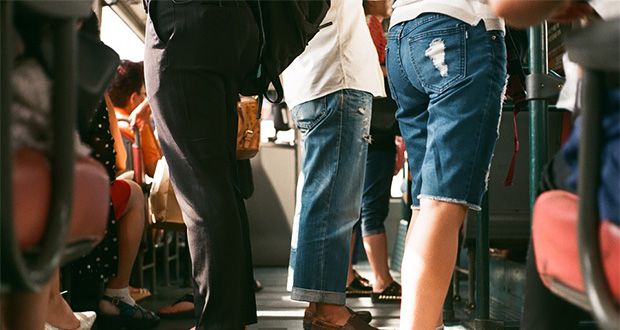Publicité
Travelling standing on the tram: How long and how crowded?
Par
Partager cet article
Travelling standing on the tram: How long and how crowded?

Public transport passengers in the country are generally accustomed to travel seated during their journeys. They should be prepared to change this travel habit. The Metro providing only limited seats, passengers should accept that they may have to travel standing on the tram. This paper explores the issue of standing on the Metro Express, the standing length of time and the crowding conditions.
- The concerns of the standing passenger
The tram of Metro Express generally accommodates 307 passengers (78 seating and 229 standing). During the off peak times, passengers would normally be securing a seat on the tram. However, during peak times, a passenger could be standing during the whole or part of the journey. The standing passenger would be having two concerns. First, how long would he be standing? Second, would the standing be in a comfortable or in a crowded condition?
- What could be the standing time on the Metro Express?
Metro operators generally design their operations on some accepted norms regarding the maximum ride time a passenger is expected to stand. In the USA, UK and Australia it is aimed that standing in a crowded condition should not exceed 15 to 20 minutes1, 2.
The ride time for the Metro Express for a sample of journeys is declared as follows:
Curepipe to Port-Louis: 41 mins Vacoas to Port-Louis: 33 mins Quatre-Bornes to Port-Louis: 23 mins
Rose-Hill to Port-Louis: 18 mins Curepipe to Rose-Hill: 23 mins
So, what could be the typical standing time on the Metro Express? Currently, a bus leaving Curepipe, Vacoas, Quatre-Bornes, Rose-Hill bound for Port-Louis, during the morning peak, invariably achieves its full complement of some 50 seated passengers at the station itself or some stops further down. This is indicative that the 78 seats of the metro tram would be taken up quickly. Therefore, for such a morning peak, most passengers from the above towns would be travelling on the tram for up to some 18 to 41 minutes standing. As well, for the stops from Beau-Bassin onwards to Port-Louis, it is expected that these passengers would perpetually be travelling standing.
- Standing passengers per square metre
A second concern for the standing passenger is the degree of crowding. A metric commonly used to measure crowding3,6 is the number of standing passengers per square metre (p/m2 ). Metro trams passenger planning are generally designed for a normal standing level of 4 passengers per square metre. A density of 4 p/m2 is considered tolerable in Europe, UK, and Australia2 ; 5-6 p/m2 is regarded as very crowded4,6. Any standing density above 6 p/m2 represents crush loading levels2, 4.
The tram of Metro Express has a normal capacity of 307 passengers with 229 standing at a presumed designed standing density of 4 p/m2 . What if there are more passengers to be accommodated in the tram? CAF, Spain, the manufacturer of the Metro Express trams, states on its website5 that the Mauritius tram has a passenger capacity of 422 passengers, but clearly specifies that at this level, the density would be 6 p/m2 . It has been pointed out earlier that a density of 6 p/m2 is distinguished as “very crowded” with passengers standing shoulder to shoulder4,6.
- Travelling standing in crowded to crush load condition
A pertinent question then: what could be the maximum number of passengers that would be travelling on the Metro Express tram at any given time? That situation would occur during the peakest of the peak, i.e. the Monday to Friday workday morning peak journey for a tram from Curepipe to Port-Louis. With the 18 Metro Express trams operating, this author has determined that for such morning peak travel, the passenger demand would be about 650 passengers per tram. For that passenger demand to be satisfied, with only 78 seats in a tram, standees would potentially reach 572. Whereas provisions have been made for 229 standees. That would mean an increase of about two and a half times on the normal number of standees.
Though the majority of the passengers would be travelling to Port-Louis as destination, several would be getting on and off during the tram journey. This would slightly decrease the number of standees travelling at any given time. Factoring this element in, it is expected that the number of standees would reach at least the double.
The doubling of the standing passengers leads to a density of 8 p/m2 , instead of the normal 4 p/m2 . Eight p/m2 is considered as crush loading condition. At that level, standing passengers are in physical contacts with each other and can- not move around without pushing6 . There would as well be inconvenience for passengers with bags and packages carried along and difficulty to move to and from the doorways.
Thus, when Metro Express would be fully operational as from year 2021, the following could be expected for the morning working day Port-Louis bound peak services:
1. The bulk of passengers would be travelling standing of up to between 18 to 41 minutes.
2. The standing would be in very crowded to crush-loaded condition.
3. Passengers from stations from Beau-Bassin onwards to Port-Louis could find themselves having constantly to travel as standees.
- Anticipated scenarios
Given that expected situation, two scenarios may surface. First, to alleviate the above situation, the trams could be made to start variously from the interchanges of Vacoas, Quatre-Bornes and Rose-Hill for Port Louis. However, as the number of trams are limited, diverting trams to these towns would mean lesser trams departing from Curepipe. Thus waiting time and standing situation from Curepipe would inevitably worsen.
Secondly, passengers actually experiencing this situation may avoid travelling by the metro altogether during peak times and use other alternative services, notably personal transport, the buses and other informal transport means. That would be contrary to the very objectives of setting up the Metro.
Dr Raj Daliah (raj.daliah@gmail.com)
REFERENCES:
<p>1. Li,Z. & Hensher, D. (2013) Crowding in public transport. Journal of Public Transportation, 16/2.</p>
<p> 2. Connor, P. (2011) Railway passenger vehicle capacity. Railway technical web pages. 13 Aug.</p>
<p> 3. Hirsch,L. & Thompson, K (2011) Commuter’s experience of crowdedness... Australian Transport Research Forum</p>
<p> 4. Qin,F. (2014) Investigating in-vehicle crowding. Mathematical problem in Engineering. Article ID 502708.</p>
<p>5. CAF (2019) https://www.caf.net/en/productos-servicios/proyectos/proyecto-detalle.php?p=294, 26 Aug.</p>
<p> 6. Sarkar, P.K. & Jain, A.K. (2017) Defining & assessing congestion inside metro trains... Intl. Journal for traffic and transport engineering 7(1)</p>
Publicité
Les plus récents






